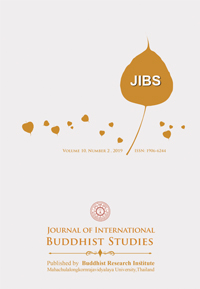A Study on the Impacts of Religious Response to the Repercussions of War : Revival of Buddhist Culture and Religiosity in Contemporary Sri Lanka
Keywords:
The Impacts of Religious, Repercussions of War, Buddhist CultureAbstract
The Buddhist concept and the mainstream economy concept derive from “craving”, both of them are totally different in every dimension. Buddhist concept can cover flaws and propose better ways to conserving the environment and solving environmental crisis. The Buddhist concept is proposed to replace mainstream economy concept and the paradigm shift should be implemented as fast as possible. New paradigm shift will systematically lead to the new form of economy and society which are environmentally friendly, induce sustainable development and strike a balance between body and mind later.
Keyword : Buddhist Concept, Solution, the Environmental Crisis
This research study was designed to unearth positive impacts of Buddhist religious response to the death of family members while serving in the security forces. More than thirty thousand members of the security forces lost their lives in the war which protracted for nearly thirty years and came to an end in May 2009. A sample of 250 Buddhist families suffering from the bereavement of deceased security personals was randomly selected for the research study from five Districts such as Gampaha, Kalutara, Rathnapura, Galle and Kurunega with equal distribution of families and data were collected by means of observation, interviews and questionnaires. A questionnaire was administered by 15 trained undergraduates who visited the selected families and worked as enumerators. The research findings were as follows:
The premature demise of 250 close male relatives such as, parents, brothers, sons and grandsons had had an adverse psychological and social impact on the wellbeing of family members and their social functioning. All the families revealed the adverse repercussions of the war with special reference to the negative impacts of sudden demise of their relatives in the military conflict as well as unexpected attacks and bomb explosions. Whereas 10 families had lost 20 members (2 per each) the rest had lost 140 members (1 per each). All were in the age range between 21 and 39 years and only 34.6% of them had been married at the time of death. Consequently 90 widows were suffering with their 219 children. Over 68% of children were schooling. The average number of the family members of the unmarried was 6. For each family the employment of the lost member had been an important source of income irrespective of other temporary sources. Returning to the normal psychological equilibrium by consoling the minds suffering from the bereavement of the deceased family members and thereby restarting the social life was a felt need of those families. They had adopted a religious means of adaptation to that situation paying special attention to follow certain Buddhist teachings, beliefs, practices and rituals in consultation with Buddhist monks known to them. Consequently, there had been a considerable change in the religious life of family members. This change had been brought about by increased frequency of (1) visiting Buddhist temples and other places of worship, (2) regular almsgivings, (3) special donations to temples, (4) participation in religious rituals, (5) special donations to religious rituals, (6) Buddhist pilgrimage (7) regular domestic religious activities, (8) learning the Dhamma, (9) Meditation,( 10) reading religious books, (10) participation in religious practices, (11) consultation of monks (12) distribution of religious books, (13) Construction and renovation of temples ,religious monuments, and places of worship (14) Social services and (15) dissemination of Dhamma through Mass media.
References
Amy, L.A. Christopher. P and Bu H. (2003) “Research: The Effect of Religious- Spiritual Coping on Positive Attitudes of Adults Muslim Refugee from Kosovo and Bosnia.” The International Journal for the Psychology of Religion.Vol.3.Issue 1. Pp.29-47.
Barnouw, V. (1982). An Introduction to Cultural Anthropology- Ethnology. Illinois: The Dorsey Press.
Bell, J. M. Edwin H.C. (2009) “Terrorism, Posttraumatic, Spiritual Coping and Mental Health” Journal of Spirituality in Mental Health. Vol.11. Issue 3. pp. 218-30
Christopher. H. Rosic, (2000) “Resource in the treatment of Dissociative Trauma Symptoms” Journal of Trauma and Dissociation.Vol.1. Issue 1.pp 69-89.
Fur Seth, I. Pal. R. (2006) An Introduction to Sociology of Religion: Classical and Contemporary Perspectives. England: Ashgat Publish- ers Ltd.
Haralambos, M and R.M. Heald. (1980) Sociology; Themes and Perspec- tives. New York: Oxford University Press.
Holm, J with J. Bowker (EDS) (1994) Themes in Religious Studies; Rites of Passage UK: Pinter Publishers.
Kevern, P. (2012) “In Search of a theoretical Basis for Understanding Reli- gious Coping; Initial Test of an Explanatory Model” ” Mental Health Religion and Culture. Vol.15. Issue 1.
Morrison, Ken. (1995) Marx, Durkheim, Weber. Formation of Modern Social Thought. New Delhi: Sage Publication.
Pargament, K.I. (1997). The Psychology of Religion and Coping: Theory, Research, Practice. New York: The Guilford Press
Silverman, William. (1990) “Reference Books in the Sociology of Religion” Review of Religion Research. New York. 87p.
Parsons, Talcott. (1959) Towards a General Theory of Social Action. Cam- bridge Mass: Harvard University Press.
Terrence. Amy. L.P. (2015) “Wartime Faith Based Reactions among Trau- matized Kosovo and Bosnia Refugees in the United States” Mental Health Religion and Culture. Vol.8. Issue 4. pp. 291-308.
Tin.Daw Mya. (1995) The Dhammapada Verses and Stories. Delhi: Central Institute of Higher Tibetan Studies, Varanasi.







